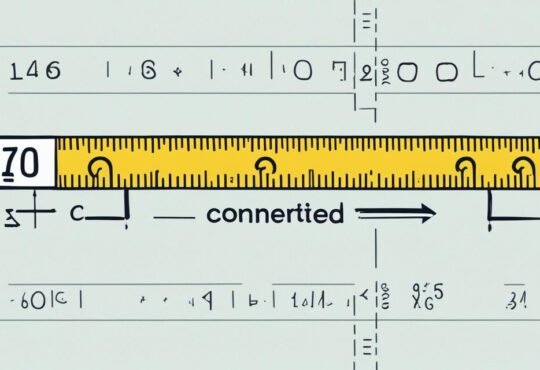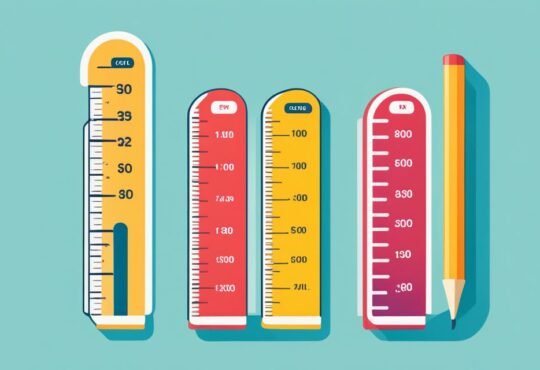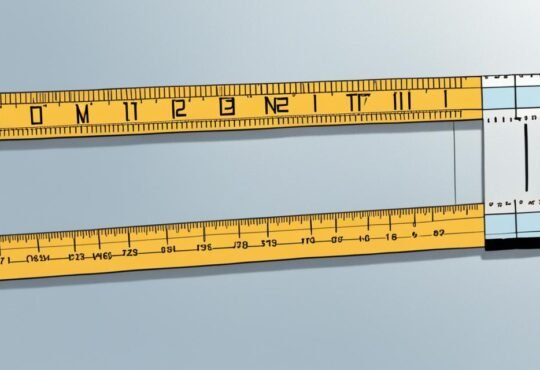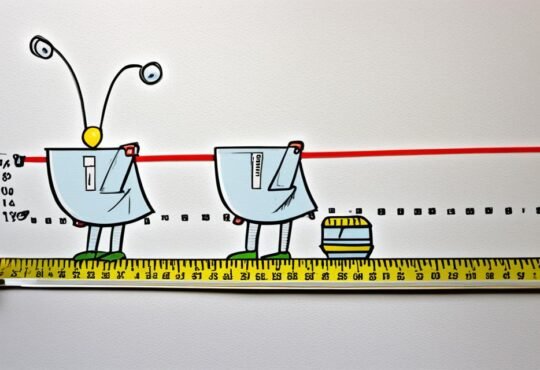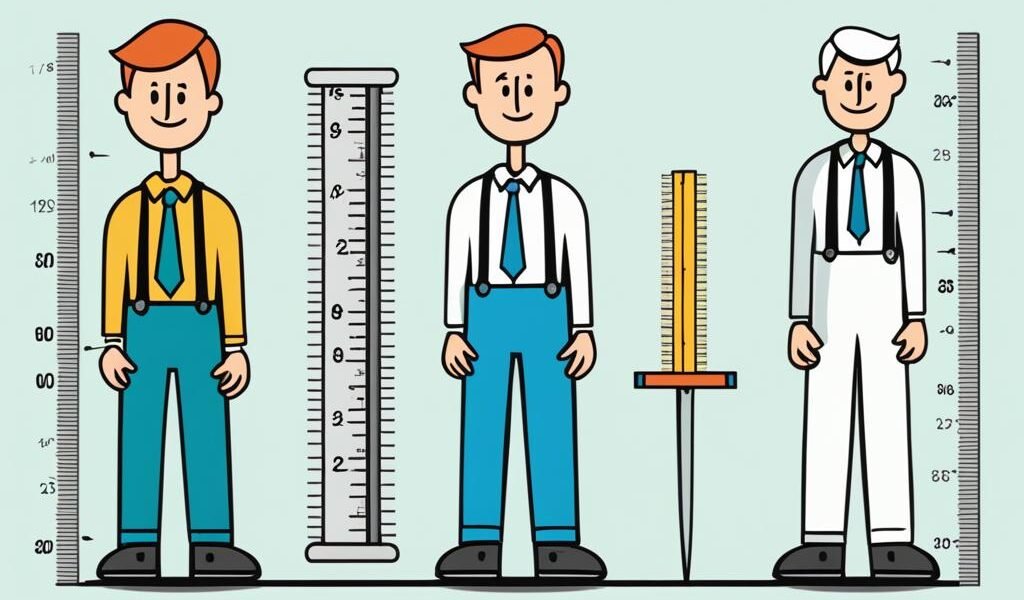
Convert 132cm to Meters – Quick & Easy Guide
Are you looking to convert 132cm to meters? Look no further! We have the quick and easy guide that will solve your conversion dilemma. Whether you’re working on a project or simply need to know the equivalent in meters, we’ve got you covered.
To convert 132 centimeters to meters, all you need is a simple formula. Just divide the value in centimeters by 100. In this case, the calculation would be 132cm / 100 = 1.32 meters. That’s it! 132 centimeters equals 1.32 meters. It’s a straightforward conversion that can be done manually or by using an online conversion calculator.
Converting measurements can be confusing at times, but rest assured that converting 132cm to meters is a breeze. No more scratching your head or wasting time searching for the correct conversion formula. Now you can confidently convert centimeters to meters whenever you need to.
Contents
Key Takeaways:
- 132 centimeters is equal to 1.32 meters.
- The conversion formula for centimeters to meters is to divide by 100.
- Manual calculation or online conversion calculators can be used for converting centimeters to meters.
- Converting 132cm to meters is a simple and quick process.
- Remember to use the formula: 132cm / 100 = 1.32 meters.
Factors to Consider for Ski Length Selection
When it comes to selecting the right ski length, several factors come into play. Considerations such as ski design, rocker/camber profile, running length, effective edge, stability, and instability all play a crucial role in determining the perfect fit for your skiing needs.
Ski Design: Different ski designs perform differently at varying lengths, so it’s important to choose a length that aligns with the intended use of your skis. For example, freestyle skis are typically shorter for maneuverability, while downhill skis are longer for stability and speed.
Rocker/Camber Profile: The rocker/camber profile of a ski affects its running length and effective edge. A ski with more rocker has a shorter actual running length, making it easier to turn and maneuver in deep snow. On the other hand, a ski with more camber provides a longer effective edge for improved edge grip and stability on groomed runs.
Stability and Instability: The desired level of stability and instability is another essential factor to consider. Skis with more stability are better suited for high-speed skiing and advanced skiers looking for a smooth ride. In contrast, skis with more instability provide a playful and forgiving experience, making them ideal for beginners and those skiing at slower speeds.
| Factors | Description |
|---|---|
| Ski Design | Different designs perform differently at varying lengths. |
| Rocker/Camber Profile | Affects the running length and effective edge of the ski. |
| Stability and Instability | Determines the preferred level of stability based on skiing style. |
By considering these factors, you can make an informed decision when selecting the length of your skis. Keep in mind your skiing style, experience level, and the types of terrains you’ll be encountering. Now that you’re equipped with this knowledge, you’ll be well-prepared to hit the slopes with confidence and enjoy your skiing experience to the fullest!
How to Set and Save Design Size in Pixels
To ensure optimal print quality, it is essential to set and save the size of your design in pixels. By following a simple formula, you can convert the dimensions of your design into pixels. This will help you achieve the desired size and maintain clarity in your printed materials.
Converting Dimensions to Pixels
To convert the dimensions of your design to pixels, multiply the desired width and length by the dots per inch (DPI) or pixels per inch (PPI) value. A DPI/PPI value of 150 or higher is generally recommended for good quality prints.
Example: Let’s say you want your image to print at 4 inches by 4 inches. To determine the number of pixels, you would multiply each dimension by 150 DPI. So, the calculation would be:
4 inches x 150 DPI = 600 pixels
Based on this calculation, your design should be set at a width of 600 pixels and a height of 600 pixels to achieve a 4-inch by 4-inch print size.
It’s important to remember that DPI represents a physical scale that affects the printed dimensions of the design. By correctly converting dimensions to pixels, you can ensure that your design appears as intended when printed.
With this knowledge, you can now confidently set and save the size of your designs in pixels. Whether you’re creating graphics for digital or print media, understanding how to convert dimensions to pixels is a valuable skill for achieving professional-looking results.
Sizing Wallpaper Designs
When it comes to sizing wallpaper designs, there are some important considerations to keep in mind. One key aspect is ensuring that the design repeats evenly across the roll width. In most cases, the standard roll width is approximately 24 inches or 60.96 cm.
To achieve the desired repeat pattern, the original design should be uploaded at the appropriate pixel dimensions. A general rule of thumb is to have the design at a width of 3600 pixels (24 inches x 150 dpi). This ensures that the design maintains its intended size and proportions when printed.
However, it is essential to note that if the design does not fit these specifications, the system may automatically resize it to maintain the desired print size. This can sometimes lead to unexpected cropping or stretching of the design, so it’s important to upload the design at the correct dimensions whenever possible.
The length of the design can vary according to your preferences or requirements. However, it is crucial to consider the vertical design repeat (VDR) when determining the size of wallpaper rolls a customer may need to purchase. The VDR refers to the height between each complete repeat of the design.
By considering both the horizontal and vertical aspects of the design, you can ensure that the wallpaper creates a seamless and visually appealing pattern when applied to walls.
Example Calculation for Wallpaper Design Repeat:
| Design Width | Design Height | Roll Width | Vertical Design Repeat |
|---|---|---|---|
| 24 inches | 10 inches | 24 inches | 10 inches |
In the above example, the design width matches the roll width, and the design height matches the vertical design repeat. This ensures that the design repeats seamlessly across the width of the roll, creating a visually consistent pattern when applied.
By accurately sizing wallpaper designs and considering design repeats, you can create stunning and cohesive wall coverings that transform any space.
Features of the Nokta Simplex+ Metal Detector
The Nokta Simplex+ metal detector is an entry-level detector that packs a punch with its high-end features, all at an affordable price. Whether you’re a beginner or an experienced treasure hunter, this metal detector offers everything you need to uncover hidden treasures.
One of the standout features of the Nokta Simplex+ is its waterproof capability. You can confidently take it underwater, as it is fully submersible up to 3 meters (10 ft). This means you can search for valuable items in lakes, rivers, and even the ocean.
When it comes to search modes, the Simplex+ doesn’t disappoint. It offers five different search modes, each specially designed to optimize detection in various environments. The Field mode is perfect for general-purpose hunting, while Park 1 and Park 2 modes are specifically tailored for searching in parks and other recreational areas. If you’re heading to the beach, the Beach mode is ideal for detecting in saltwater environments. And for those who prefer a more versatile approach, the All Metal mode allows you to detect all types of metals.
The Nokta Simplex+ also comes with a built-in wireless module, making it compatible with Nokta’s 2.4 GHz Green Edition wireless headphones. This means you can enjoy a wire-free detecting experience while still staying connected to the sounds of your treasure hunting adventures.
Other notable features of the Nokta Simplex+ include a vibration mode for silent detection, a frequency shift function for eliminating electromagnetic interference (EMI), and a range of search coil options to suit your specific needs. Additionally, its lightweight design and retractable shaft make it easy to transport and store, ensuring convenience and comfort during your metal detecting expeditions.
Discover the world of metal detecting with the Nokta Simplex+. Its impressive features, waterproof capability, versatile search modes, and wireless headphone compatibility make it an excellent choice for both beginners and seasoned treasure hunters alike.
| Features | Description |
|---|---|
| Waterproof | The Simplex+ can be fully submerged up to 3 meters (10 ft) underwater, allowing for underwater metal detecting. |
| Search Modes | Choose from five search modes: Field, Park 1, Park 2, Beach, and All Metal, for optimal performance in different environments. |
| Wireless Headphone Compatibility | The built-in wireless module is compatible with Nokta’s 2.4 GHz Green Edition wireless headphones, providing a wire-free detecting experience. |
| Vibration Mode | The vibration mode allows for silent detection, ensuring you don’t miss any valuable finds. |
| Frequency Shift | The frequency shift function helps eliminate electromagnetic interference (EMI) for a more accurate detection experience. |
| Search Coil Options | Choose from a variety of search coil options to customize your metal detecting experience. |
Conclusion
In summary, converting 132cm to meters is a straightforward calculation that involves dividing the length in centimeters by 100. This simple formula allows for easy conversion between these two units of measurement.
When selecting ski length, it is crucial to consider various factors such as ski design, rocker/camber profile, running length, and stability. These elements greatly influence the performance and handling of the skis, ensuring an optimal skiing experience based on individual preferences and skill levels.
To achieve optimal print quality, designers should follow the provided formula to set and save design sizes in pixels. By multiplying the desired dimensions by the DPI or PPI value, the resulting number of pixels ensures that the design will be properly displayed with sufficient detail and clarity.
When sizing wallpaper designs, it is essential to ensure an even repeat across the roll width. By adhering to this principle and considering the vertical design repeat, customers can determine the appropriate size of rolls needed for their specific wallpaper projects.
The Nokta Simplex+ metal detector offers an impressive range of features at an affordable price point, catering to both beginners and experienced detectorists. With its waterproof capabilities, versatile search modes, and compatibility with wireless headphones, the Simplex+ provides convenience, functionality, and performance for metal detecting enthusiasts.
FAQ
How do I convert 132cm to meters?
To convert 132cm to meters, simply divide the value in centimeters by 100. So, the calculation would be 132cm / 100 = 1.32 meters.
What factors should I consider when selecting ski length?
When selecting ski length, factors to consider include ski design, rocker/camber profile, running length, and stability.
How do I set and save design size in pixels?
To set and save design size in pixels, multiply the desired dimensions (width and length) by the DPI or PPI value. For example, if you want an image to print at 4 inches by 4 inches with a DPI of 150, you would multiply each dimension by 150 to get the number of pixels.
How do I size wallpaper designs?
To size wallpaper designs, ensure that the design repeats an even number of times across the roll width. The original design should be uploaded at the appropriate width, typically 24 inches or 60.96 cm.
What are the features of the Nokta Simplex+ metal detector?
The Nokta Simplex+ metal detector is waterproof up to 3 meters (10 ft) underwater and offers five search modes. It has a built-in wireless module, vibration mode for detection, frequency shift for eliminating EMI, and various search coil options.

